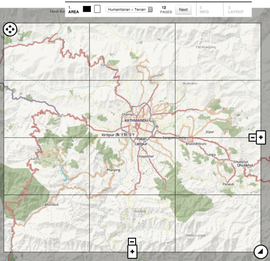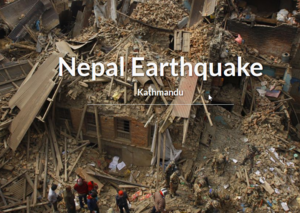2015 Nepal earthquake
From April 25 to June 8 2015, a significant crowdsourcing effort of the OSM community with more than 7,500 contributors from around the world supported the logistic of the Nepal government, UN Agencies and International organizations responding the Nepal Earthquake human relief.
Thanks to the various organizations that supported us, including the Aerial imagery providers, the Mapathon organizers and other Digital Humanitarian Organzations that worked closely with us to monitor the situation.
This Activation is now closed.
| General Information | |
|
The 2015 Nepal earthquake struck Nepal on 25th April with a magnitude of 7.8, followed by aftershocks including a large magnitude 7.3 quake on 12 May. The initial earthquake struck with an epicentre in the mountains to the northwest of Kathmandu, and aftershocks around the city of Kathmandu. The later 7.3 earthquake struck to the northeast of Kathmandu towards Mount Everest and affecting regions in Southern China. The quakes killed at least 8000 people, and left many in desperate need of shelter, medical help, food and other aid. What We Do Who Can Use Our Maps? How To Get Involved
Coordination
Donate to the OpenStreetMap Foundation The Humanitarian OpenStreetMap Team also need your donations, to help funding humanitarian mapping projects and development/maintenance of systems such as the Tasking Manager. Donate to the Humanitarian OpenStreetMap Team
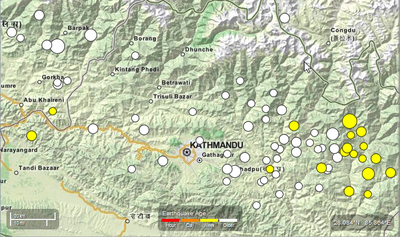 Map from USGS showing epicentre and aftershock locations on an OpenStreetMap (mapquest) base map 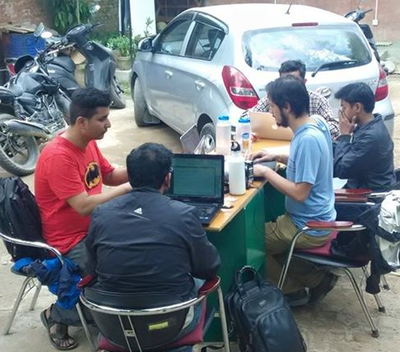 OSM Contributors at Kathmandu Living Labs operational one day after the earthquake. They support the government and international organizations from Kathmandu while the global OSM community rapidly improve the map from afar | |
The Response
The Humanitarian OpenStreetMap Team Coordination volunteers and the Kathmandu Living Labs (KLL) Volunteers conjointly assured identification of mapping needs and interfaced with the various humanitarian organizations that responded to the Nepal population needs in Kathmandu and the remote villages in the mountains. KLL also interfaced with the Nepal government and provided various services to the teams arriving in Kathmandu.
Roads and buildings were rapidly mapped with the remote support of the OpenStreetMap community from around the world. From post-disaster imagery, Spontaneous camps were located in Kathmandu. Potential helicopter landing areas in the mountains were also identified. The various mapping services offered are described below.
Map and Data Services
About OpenStreetMap
OpenStreetMap offers an online map and spatial database that is updated by the minute. Various online maps are based on OpenStreetMap, including Navigation tools such as OSRM. Tools and services allow data extracts for GIS specialists, routable data for Garmin GPS, GPS navigation with smartphones and other device-compatible downloads. With an Internet connection, regular syncing is possible, because there is open access to the community-contributed data as it comes in. Also bulk with downloads of OpenStreetMap data are ideal for use offline. In addition, maps can be printed to paper, if needed.
Browse the Activation Area to get a feel for the data that is currently available. Different map styles, including a special Humanitarian style, can be selected on the right side of the screen. Though some data may not render (appear) on the online map, it can be exported from the underlying database for other uses requiring more detail (See export section below).
Paper Maps
Large poster-size maps and letter-size paper atlases of custom areas can be printed:
- FieldPapers Paper Maps with grid for field survey or general navigation purposes,
- MapOSMatic Large Paper Maps with grid, street index and POI, good for command centers, hospitals, etc.
- Kathmandu Living Labs Quake Maps printable PDF extracts of major cities
Exporting OpenStreetMap data
Frequent updates
There is more than one source for the same file format. This should assure a constant access to data if any problems arise from one host.
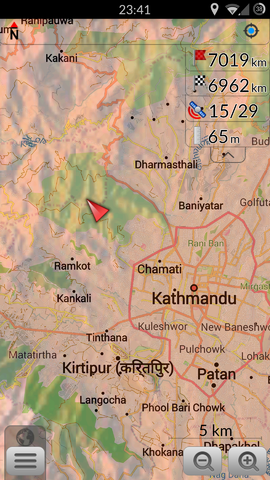
Use on your phone or tablet (no network connection required).
| OpenStreetMap Exports | OSM Format | ShapeFiles for GIS softwares | Offline Navigation on Small Devices |
|---|---|---|---|
| Daily updates, Central Nepal (osm contributor) | .pbf | Shapefile(Esri) 13 Thematic Layers |
OSMAnd obf(~20Mb) GPS Garmin IMG |
| 30 minutes updates by geofabrik see download directory |
.pbf | Shapefile(Esri) | GPS Garmin IMG |
| Hourly updates milovanderlinden | .pbf | OSMAnd obf(~22Mb) | |
| 30 minutes update Thematic layers (roads, IDP camps, land use, amenities, place names) GFDRR Innovation Lab from geofabrik |
.pbf | Shapefile(Esri) | |
| Updated every few days by kleineisel.de routable, contains height contour lines (from SRTM data), the map design is similar to topo maps. |
GPS Garmin IMG | ||
| Updated every two hours Mail | Garmin, Android, Garmin-Basecamp, QLandkarte |
Information about the various OSM export formats
- OSM.pbf: These compressed OSM files are recognized by various GIS softwares.
- Shapefile: This data can be imported to GIS software, such as Quantum GIS or ESRI ArcGIS for Desktop.
- OSMAnd.OBF: OSMAnd / Android and iPhone Offline map and navigation
Note: launched 2015-04-19, the first iPhone version does not yet integrate all the functionalities of the Android version.- » Android File manager: Move the obf file from the download to the OSMAnd directory
- LearnOSM Tutorial Configure OSMAnd, and Offline map navigation
- How to use Voice Navigation
- Kathmandu Living Labs Quake Maps OSMAnd exports
- GPS.IMG: Garmin GPS format
- » Rename the IMG file to gmapsupp.img and move it to the Garmin directory of the GPS card
- Other Mobile devices: See other Mobile device products.
OpenStreetMap Response
Ongoing updates about this activation are posted on the HOT mailing list
Coordination and discussion may also happen on HOT's IRC Channel (direct link) or Mumble Server
The general Nepal remote mapping guide may be useful for help with identifying Nepalese features
How You Can Contribute
Edit the Map
- You can contribute from the Internet by tracing buildings, roads, waterways, etc. To react rapidly to support humanitarians deploying, we need a lot of contributors for remote editing. Visit LearnOSM.org to get started. See the specific LearnOSM Task Manager tutorial. The best way to learn is to participate to Mapathons where experience contributors of your community will show you the basics of editing.
- More experienced OSM contributors are invited to read the guidelines on Tagging Roads in Nepal and to revise the classification of roads. You also can assure the quality of the mapping by validating the Task manager tasks or using the various OSM Quality control tools.
- Humanitarian field teams and knowledgeable local people also are essential. You can complete the map by adding the names of roads or various infrastructure items. You even can edit the map using small mobile devices. In addition, applications are available for online or offline mapping.
- Add a Note or report an Error using the Notes feature on the Online Map. OSM contributors will edit the map from your comments.
Task Manager projects
The following projects have been set-up on the OSM Tasking Manager. The complete list of HOT projects for this 2015 Nepal event are all listed (alongside others) on http://tasks.hotosm.org/ :
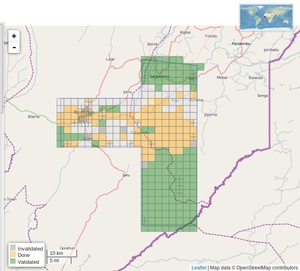
» LearnOSM Task Manager tutorial
Basic contributor training video. task:1090
Experience contributor training video. task:1062
Nepal Images of houses, villages, highways
» Gallery 1 Pre and Post-Disaster
» Gallery 2
| Job No. | Location | What to map | Imagery expiration | Task Mapping Status | Task Validation Status |
|---|---|---|---|---|---|
| TASKS FOR ALL CONTRIBUTORS URGENT |
VALIDATION BY EXPERIENCED CONTRIBUTORS ONLY | ||||
| #1018 (priority) | Surrounding the greater areas outside Kathmandu | 2nd pass for detailed mapping | N/A | In Progress (94%) | In Progress (89%) |
| #1043 (priority) | Solukhumbu ( Additional affected district ) | Detailed mapping | N/A | In Progress (95%) | In Progress (63%) |
| #1048 (priority) | Tanahu ( Additional effected district ) | Detailed mapping | N/A | Completed | In Progress (18%) |
| TASKS FOR ALL CONTRIBUTORS High priority |
VALIDATION BY EXPERIENCED CONTRIBUTORS ONLY | ||||
| #1070 (priority) | Kaligandaki Landslide - Myagdi (High Alert District) | Detailed mapping | N/A | In Progress (23%) | In Progress (10%) |
| #1071 (priority) | Kaligandaki Landslide - Baglung (High Alert District) | Detailed mapping | N/A | In Progress (12%) | In Progress (1%) |
| #1072 (priority) | Kaligandaki Landslide - Parbat (High Alert District) | Detailed mapping | N/A | In Progress (27%) | In Progress (1%) |
| #1073 (priority) | Kaligandaki Landslide - Parbat (High Alert District) | Detailed mapping | N/A | In Progress (27%) | In Progress (4%) |
| TASKS FOR EXPERIENCED CONTRIBUTORS ONLY | |||||
| #1010 | Banepa | IDP Camps | N/A | Completed | In Progress (0%) |
| #1044 Experienced mappers | Trisuli Valley | IDP camps and damaged areas. | N/A | Completed | In Progress (7%) |
| #1046 Experienced mappers | Kadichaur | IDP camps and damaged areas. | N/A | In Progress (40%) | In Progress (3%) |
| TASKS COMPLETED / ARCHIVED | |||||
| #190 (priority) | Kathmandu Valley, includes more imagery | buildings only | N/A | Archived | |
| #994 | North of Kathmandu and remote mountain areas | roads only | N/A | Archived | |
| #995 | East of Kathmandu and remote mountain areas | roads only | N/A | Archived | |
| #1001 | West of Kathmandu and remote mountain areas | roads only | N/A | Archived | |
| #1002 | North West of Kathmandu - Manaslu Conservation Area | roads, villages, buildings | N/A | Archived | |
| #1003 | North of Dunche, includes more imagery | detailed map | N/A | Archived | |
| #1004 | South West of Kathmandu | roads | N/A | Archived | |
| #1006 | North of Narayangadh and east of Pokhara | Residential areas and buildings | N/A | Archived | |
| #1008 | Kathmandu | IDP Camps | N/A | Archived | |
| #1009 | Gorkha | Residential areas and buildings | N/A | Archived | |
| #1014 | Sindhupalchowk | heavily affected area, detailed mapping needed | N/A | Archived | |
| #1015 | Dhunche Rasuwa | heavily affected area, detailed mapping needed | N/A | Completed | Completed |
| #1016 | Langtang Rasuwa | heavily affected area, detailed mapping needed | N/A | Completed | Completed |
| #1023 Experienced mappers | Northern Dhanding | Identifying helicopter landing sites | N/A | Archived | |
| #1024 Experienced mappers | Gorkha | IDP camps and damaged areas. | N/A | Archived | |
| #1025 Experienced mappers | Bidur | IDP camps and damaged areas. | N/A | Archived | |
| #1026 Experienced mappers | Sindhupalchowk | Identifying helicopter landing sites | N/A | Archived | |
| #1030 Experienced mappers | Outside Kathmandu | IDP camps and damaged areas. | N/A | Archived | |
| #1033 Experienced mappers | Langtang | IDP camps and damaged areas. | N/A | Archived | |
| #1047 (priority) | Palpa ( Additional effected district ) | Detailed mapping | N/A | Archived | |
| #1058 Experienced mappers | Kalyanpur | IDP camps and damaged areas. | N/A | Archived | |
| #1059 Experienced mappers | Langtang NE | IDP camps and damaged areas. | N/A | Archived | |
| #1060 Experienced mappers | Gorkha north | IDP camps and damaged areas. | N/A | Archived | |
Overview of tasks and imagery coverage on uMap
Summary statistics of all tasks can be found on the Nepal Mapping Progress Dashboard
General map improvements
As well as small square shaped contributions, we can look to make more wide ranging improvements. Reviewing/improving the overall map data consistency is very useful, but that is also most prone to edit conflicts so please save often and understand in the busy time like this you might encounter edit conflicts.
Any local knowledge like infrastructure, buildings or road names that you know and can positively identify, are extremely helpful to responding organizations.
Mapping roads is a high priority, the Nepal roads page for proposed road conventions or guidelines for road categorization is a good reference.
OpenStreetMap is a editable map, so we can improve it if there's anything missing/wrong (Beginners' guide). This is particularly useful if you have any local knowledge or you can survey things on-the-ground (names of streets etc.).
People who have local knowledge but do not know how to edit OpenStreetMap are still vital to our aid efforts. You can share your local knowledge with the OpenStreetMap "Notes" feature. This lets you drop a marker and attach a note with information about the location/building/road that an experienced OSM mapper will then put in the OSM database. For simple instructions on how to share your knowledge with our mappers please see this quick guide to using notes:
How to easily share local knowledge with OSM Notes
Imagery and Reference Maps
Pleiades, Airbus Defense & Space
2014-04-27 Pleiades 2014-11-29 and 2015-04-27 have been used for post-disaster IDP camps identification in Kathmandu.
Imagery Requests
Fresh and archive satellite imagery is being requested through international activations charter and imagery providers. HOT has identified areas that need high resolution imagery for both base mapping and damage assessment. Areas requested are highlighted in bright blue on this map:
http://umap.openstreetmap.fr/en/map/hot-imagery-coordination_37804#9/28.0623/85.2251
Imagery hosted by Google Crisis Response
DigitalGlobe, Airbus D&S and Skybox imagery prepared, tiled, and hosted by the Google Crisis Response team, and shown on Google CrisisMap is allowed to be traced in OSM. See Nepal imagery hosted by Google Crisis Response for a list of images and corresponding URLs.
Bing
Bing imagery coverage as of 2015-04-25 with TM #994 and #995 overlay. (coverage source TMS: https://ant.dev.openstreetmap.org/bingimageanalyzer/tile.php/{z}/{x}/{y}.png)
DigitalGlobe
Indian Space Research Organization
Cartosat-2 post-earthquake for Kathmandu imagery as of 2015-04-27.
Mapbox
For some of TM #1001 the Bing imagery may be cloudy or unavailable, MapBox has coverage, but not at all zoom levels.
Formosat-2
http://nepal-quake.colife.org.tw/ Still pending license clarification
ESA Sentinel-1A
https://www.asf.alaska.edu/sentinel/nepal-data-feeds/ (License seems compatible)
Public domain topo maps
There are two sets of public domain topographic maps available which cover large portions of Nepal. Both sets are 1:250,000 scale, which means they are only really useful for adding place names, of which the maps list thousands. Before we manually copy in place names from these maps we will manually merge in the GNS place names for the area, which will cut down on some of the work. After that is done, we will create task manager jobs to go through and systematically enter all of the place names on these topographic maps.
| Layer | JOSM TMS Url | View |
|---|---|---|
| US Army Map Service (AMS) | tms[15]:http://mapwarper.net/layers/tile/345/{zoom}/{x}/{y}.png | View online |
Other Data
- USGS shakemap data (click on 'download')
- Humanitarian Data Exchange - Nepal Earthquake
- NGA GEOnet Names Server (GNS)
- High resolution Nepal weather
- Near real-time MODIS imagery
- World Pop 100M gridded population for Nepal - currently being updated
- Gridded Population of the World
- UNOCHA Nepal data-sets
- Freizeitkarte Nepal Topographic maps for Garmin and Android (with periodic updates)
- www.kleineisel.de Topographic OSM map for Garmin devices with contours
- Nepal Topo Maps 1:25,000 This site contains a bunch of topographic maps. They are copyrighted so we cannot use them without permission from the creators. The copyright is His Majesty's Government of Nepal, Survey Department. Please coordinate on the HOT mailing list before sending any requests to the org to avoid sending multiple requests.
Other Resources
Nepal Earthquakes Reporting Site (Kathmandu Living Labs Ushahidi)
Disaster OpenRouteService for Nepal including POI, damaged buildings etc. (GIScience HD)
EMSC (European Mediterranean Seismological Centre) provides real time earthquake information
Write-ups and in the News
- 25-Apr-2015: Articles on ReliefWeb by Shadrock Roberts describing all the DH group efforts
- 27-Apr-2015: Laura Bliss - Another Way to Help Humanitarian Efforts in Nepal: Start Mapping - In: CityLab
- 27-Apr-2015: Gizmodo - Two Ways You Can Join Nepal's Earthquake Relief Effort From a Computer
- 27-Apr-2015: Hyperallergic.com - Open Source Maps Help Guide Nepalese Earthquake Relief
- 27-Apr-2015: 'People Want to Help' - Digital Volunteers Around the World Scour Nepal Data
- 27-Apr-2015: Xataka.com - El desastre de Nepal e Internet: así se está volcando la red más allá de mostrarnos la tragedia
- 28-Apr-2015: The News Minute - How a group of individuals from all over India are making maps to help rescue teams in Nepal
- 28-Apr-2015: Wired.co.uk - How Nepal's earthquake was mapped in 48 hours
- 28-Apr-2015: Adele Peters - One Way You Can Help Nepal Right Now: All You Need Is A Computer And A Little Time - In: Co.Exis
- 28-Apr-2015: Siddharta Mishra - How a group of individuals from all over India are making maps to help rescue teams in Nepal - In: The News Minute
- 29-Apr-2015: Franziska Schwarz und Hakan Tanriverdi - Hilfe für Nepal per Mausklick - In: Süddeutsche Zeitung
- 01-May-2015: Mapping the aftermath, Nepali Times
- 01-May-2015: How 'Crisis Mapping' Is Shaping Disaster Relief in Nepal - National Geographic
- 01-May-2015: How hundreds of volunteer mappers are helping to keep Nepal earthquake aid from getting lost - Scroll.in
- 01-May-2015 Nepal Aid Workers Helped by Drones, Crowdsourcing - Wall Street Journal
- 01-May-2015: 3 Ways Nepalis Are Using Crowdsourcing to Aid in Quake Relief – New York Times
- 02-May-2015: Robinson Meyer - The Internet Mapmakers Helping Nepal - In: The Atlantic
- 02-May-2015: Sky news (UK) TV short interview with Harry Wood
- 06-May-2015: BBC - How 'crisis mapping' is helping relief efforts in Nepal
- 08-May-2015: नेपाल बनाउने नक्शा – Setopati.com
- 10-May-2015: Mapping to help relief workers in Nepal
- 10-May-2015: Mapping the Quake
- 11-May-2015: How maps are saving lives as Nepal recovers from its earthquake
- 12-May-2015: Bringing drones down to earth
- 12-May-2015ː Finding the way: Geomatic Support Team creates maps in Nepal
- 13-May-2015: How maps are saving lives as Nepal recovers from its earthquake
- 13-May-2015: Nepal’s Aid System Is Broken. So These Lifesavers Hacked It
- 14-May-2015: BBC Click TV - Nepal quake: Could a mapping project help with recovery?
- 14-May-2015: We are a bridge between victims with rescue and relief workers – My Republica
- 18-May-2015: OpenNepal Improving information access to support quake relief – leadership from local actors Nepal
- 18-May-2015: opensource.com OpenStreetMap responds in Nepal, by Andrew Wiseman and Pierre Béland
- 18-May-2015: Maps for Nepal
- 19-May-2015: KLL deploys QuakeMap.org – connecting people to relief efforts
- 21-May-2015: Kantipur Television delivers news about Quake-Map
- 21-May-2015: The White House Mapathon - By The White House
- 26-May-2015: Saving Culture and History
- 25-April-2016: OpenStreetMap responds in Nepal - By The Guardian
- 08-June-2016: Open source and open data's role in Nepal earthquake relief
Documented Usage
Map Visualizations
- Reach Initiative Kathmandu Reference Maps: [1]
- American Red Cross Map Library: [2]
- MapAction Reference and Orientation Maps: [3]
- ReliefWeb/PDC: [4]
- Nepal Earthquake Map - April 25, 2015/Overview: [5]
Online Maps
- OSMCompare Before / After map by Pierre Béland:
- UNOSAT Live Maps
- ORS Disaster Map Nepal
- Mountain GeoPortal Potentially Dangerous Glacial Lakes of Nepal
- NY Times IDP Camps
Routing tools
Disaster OpenRouteService for Nepal including POI, damaged buildings etc. (GIScience HD) http://www.openrouteservice.org/disaster-nepal (more info: http://giscienceblog.uni-hd.de/2015/04/28/disaster-openrouteservice-for-nepal/ )

